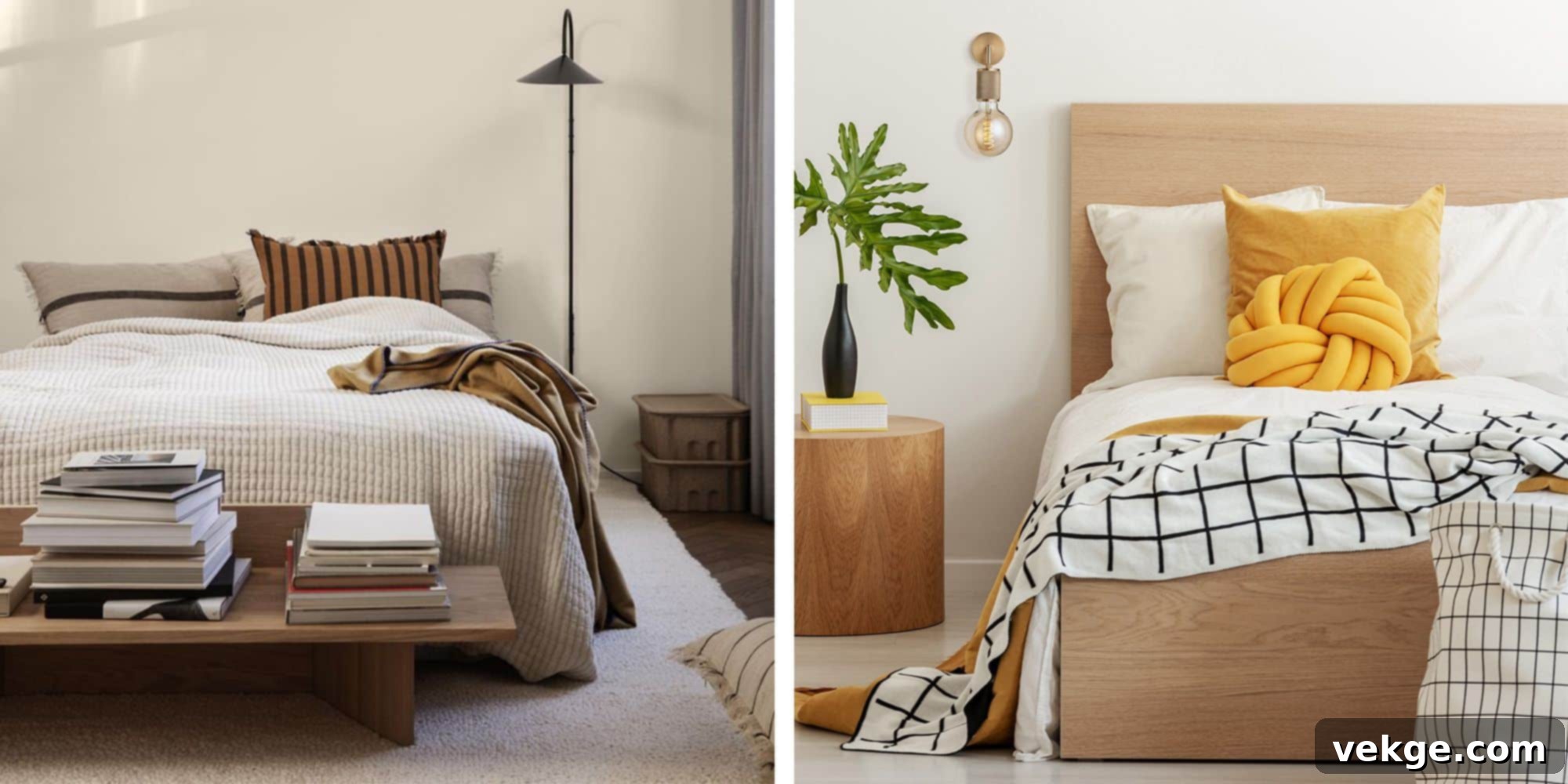Ultimate Guide to Caring for Your Scandinavian Bed: Enhance Longevity & Style
Scandinavian beds are more than just furniture; they represent a philosophy of design that marries simplicity, minimalism, and purposeful functionality. This harmonious blend creates an intrinsically calming and inviting environment, essential for restful sleep. Crafted with meticulous attention to detail and precision, these beds embody the captivating qualities for which Scandinavian design is globally renowned: understated elegance, durability, and a deep connection to nature.
Their sleek, minimalist frames beautifully showcase the inherent charm of natural woods such as oak, pine, and birch. The distinct grain patterns and textures of these woods are not merely aesthetic features; they tell a story of natural beauty, bringing an organic warmth into your bedroom space. Every curve and joint in these Scandinavian bed frames is thoughtfully designed, reflecting a commitment to both visual appeal and lasting comfort. A major emphasis is placed on ensuring superior comfort and fostering high-quality sleep, with the mattress playing a pivotal role in delivering optimal rest. These beds are designed to be highly functional without ever compromising their elegant aesthetics, making them a cornerstone of a serene bedroom.
Comprehensive Care Guide for Your Scandinavian Bed
Investing in a Scandinavian bed is a commitment to timeless design and enduring quality. To ensure your bed remains a durable, sturdy, and purposeful centerpiece in your bedroom for years to come, it requires a thoughtful and consistent care routine. Adhering to a few important steps will not only preserve its aesthetic appeal but also maintain its structural integrity and hygienic conditions, allowing you to fully enjoy its benefits.
1. Regular Cleaning for Lasting Luster
Consistent cleaning is fundamental to preserving the beauty and longevity of your Scandinavian bed. Regular dusting and wiping are crucial to prevent the accumulation of dirt, dust, and debris on the wooden surfaces, which can scratch the finish over time and dull its natural luster. Incorporating this into your routine ensures that your sleep environment remains clean and inviting.
- Dusting Frequency: Aim to dust your bed frame at least once a week. Use a soft, dry microfibre cloth, moving gently along the wood grain to pick up dust effectively without scratching the surface.
- Wiping Surfaces: Periodically, or when dust build-up is more visible, wipe the wooden surfaces with a slightly damp (not wet) soft cloth. Ensure the cloth is wrung out thoroughly to avoid excess moisture. For a deeper clean, consider using a pH-neutral wood cleaner specifically designed for furniture. Always test any cleaning product on an inconspicuous area first.
- Avoid Harsh Chemicals: Steer clear of abrasive cleaners, ammonia-based products, or harsh chemical agents. These can strip the natural oils from the wood, damage its finish, and cause discoloration over time.
- Targeting Nooks and Crannies: Pay special attention to intricate details, joints, and corners where dust can easily settle. A soft-bristled brush, a cotton swab, or even the soft brush attachment of a vacuum cleaner can be very effective for these hard-to-reach areas.
- Wood Protection: Every few months, consider applying a high-quality furniture wax or oil specifically formulated for natural wood. This helps to nourish the wood, enhance its natural sheen, and create a protective barrier against moisture and minor scratches. Follow the product manufacturer’s instructions carefully for application.
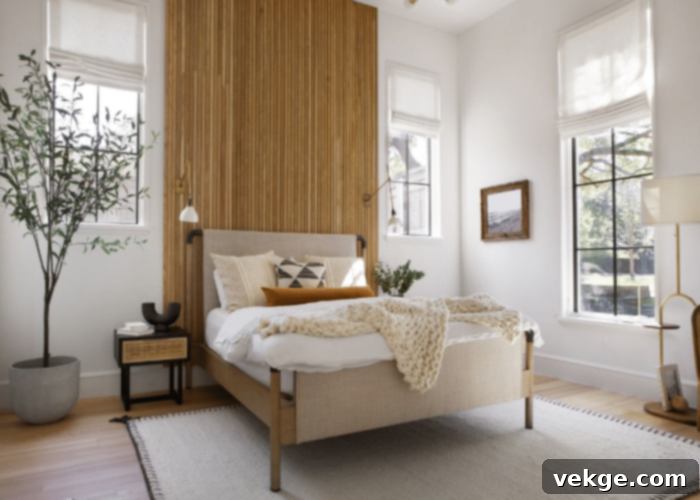
2. Meticulous Mattress Care
While the bed frame often takes center stage, the mattress is equally vital for both hygiene and comfort, making its care paramount. Special attention should be given to mattresses in Scandinavian beds, as dust, dirt, and even moisture can accumulate beneath them, potentially leading to the growth of mold or mildew, especially on slats or platforms.
- Under-Mattress Cleaning: Regularly lift your mattress to clean the bed frame’s slats or solid platform beneath. Use a vacuum cleaner with a brush attachment or a long, soft-bristled brush to remove any accumulated dust, debris, and potential allergens. This not only prevents mold but also ensures better air circulation around your mattress. Aim to do this monthly or quarterly.
- Mattress Vacuuming: Vacuum the surface of your mattress every few weeks to remove dust mites, dead skin cells, and allergens. Use the upholstery attachment on your vacuum cleaner for best results.
- Flipping and Rotating: To ensure even wear and prolong its lifespan, flip and/or rotate your mattress every 3-6 months, as recommended by the manufacturer. This helps maintain its support and comfort levels.
- Protective Covers: Invest in a high-quality mattress protector and pillow protectors. These create an effective barrier against spills, stains, dust mites, and allergens, significantly extending the life and cleanliness of your bedding. Look for waterproof yet breathable options.
- Washing Bedding: Wash your sheets, pillowcases, and duvet covers regularly (weekly is ideal) using gentle detergents. This preserves the quality of the fabric and keeps your sleep environment fresh. For those in Singapore seeking a mattress that combines both style and comfort with ease of maintenance, the HipVan Mattress Singapore offers a range of modern designs tailored to contemporary interiors, designed to be durable and simple to care for with regular cleaning and protective covers.
- Air Circulation: Occasionally, allow your mattress to air out by removing all bedding for a few hours. This helps to dissipate moisture and keep it fresh.
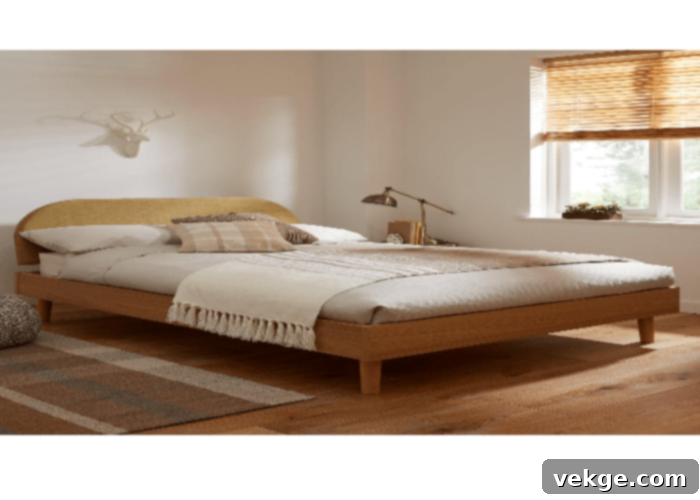
3. Protecting Wood from Direct Sunlight
The hallmark of Scandinavian design often includes light and earthy tones, which contribute to a bright and airy aesthetic. However, exposing natural wood to direct sunlight for prolonged periods can lead to undesirable effects over time, diminishing the bed’s original charm.
- Fading and Discoloration: Ultraviolet (UV) rays from the sun can cause the wood to fade, bleach, or change color unevenly. This discoloration can make the wood appear aged, worn, and of poorer quality, detracting from its natural beauty. Some wood types are more susceptible to this than others.
- Drying and Cracking: Direct sunlight can also dry out the wood, causing it to shrink, crack, or warp over time. This not only affects the appearance but can also compromise the structural integrity of the bed frame.
- Strategic Placement: Whenever possible, position your Scandinavian bed in a part of the bedroom where it won’t receive direct, intense sunlight for extended periods.
- Window Treatments: Utilize curtains, blinds, or shades in your bedroom to shield your bed from harsh sunlight, especially during peak sun hours. Blackout curtains or those with UV-protective linings are particularly effective.
- Protective Barriers: If repositioning isn’t an option, consider covering exposed wooden surfaces with a lightweight bedsheet or a throw during the day when sunlight is strongest. While this might temporarily obscure the design, it offers crucial protection.
- UV-Resistant Finishes: If you are purchasing a new bed, inquire about any UV-resistant finishes. For existing beds, consult with a furniture care expert about applying a protective clear coat that offers UV protection, if appropriate for your wood type and finish.
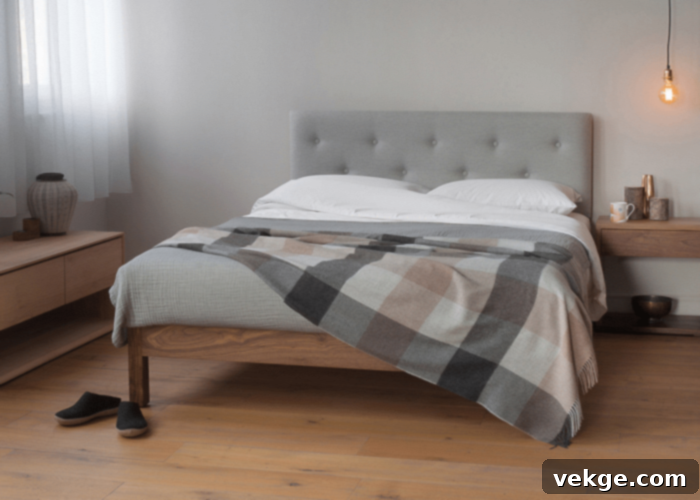
4. Maintaining Optimal Temperature and Humidity
As a natural material, wood is highly responsive to its environment, particularly to fluctuations in temperature and humidity. Maintaining comfortable and stable humidity levels in your bedroom is crucial for the long-term health and appearance of your Scandinavian bed frame.
- Humidity Fluctuations: Extreme changes in humidity levels can have detrimental effects on wood. Too much dryness can cause the wood to contract, leading to cracking, splitting, or warping. Conversely, excessively high humidity can cause the wood to swell, potentially weakening joints, encouraging mold growth, and sometimes leading to a strong, musty odor.
- Ideal Conditions: Wood furniture generally thrives in environments where the relative humidity is maintained between 40% and 60%, and the temperature is kept relatively stable, ideally between 60-75°F (18-24°C).
- Regulating Humidity: In dry climates or during winter months when heating systems can significantly lower indoor humidity, a humidifier can be highly beneficial. It helps to add moisture back into the air, preventing the wood from drying out. In humid climates, a dehumidifier or air conditioning can help to reduce excess moisture, protecting against swelling and mold.
- Ventilation: Ensure good air circulation in your bedroom. Proper ventilation helps prevent stagnant air and moisture build-up, which can be particularly damaging to wooden furniture.
- Placement Considerations: Avoid placing your bed too close to direct heat sources like radiators, fireplaces, or air conditioning vents, as these can create localized areas of extreme temperature and humidity, accelerating wood damage.
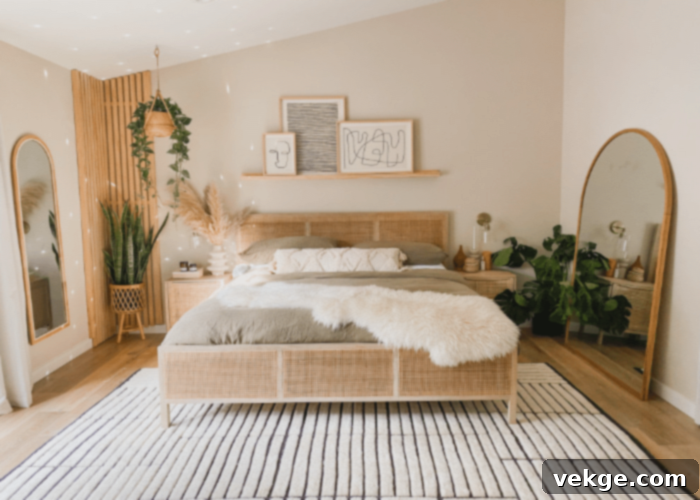
5. Essential Structural Checks and Styling Tips
Beyond environmental factors and regular cleaning, several other practical considerations contribute significantly to the long-term health and aesthetic appeal of your Scandinavian bed. Paying attention to these often-overlooked details can prevent minor issues from escalating into major problems.
- Proper Assembly: The journey of a durable bed begins with its initial assembly. Ensure that your Scandinavian bed was correctly assembled according to the manufacturer’s instructions. Incorrect assembly can lead to instability and premature wear.
- Periodic Structural Checks: Make it a habit to periodically inspect the bed’s joints, screws, and bolts, perhaps every six months. Over time, these can loosen with daily use. Gently tighten any loose fasteners with the appropriate tools to maintain the bed’s stability and prevent wobbling or squeaking. This quick check can prevent significant structural damage down the line.
- Prompt Repairs: Should you notice any minor damage, such as a loose slat, a small scratch, or a wobbly leg, address it immediately. Quick repairs and maintenance prevent the issue from worsening and save you from more extensive and costly interventions later.
- Mindful Styling: Scandinavian design champions minimalism and functionality, and your styling choices should reflect this philosophy. Avoid overcrowding your bed with an excessive number of pillows, heavy throws, or too many decorative items. Opt for a few high-quality, thoughtfully chosen items that complement the bed’s design and maintain a sense of calm and order. This not only enhances the aesthetic but also reduces undue stress on the bed frame.
- Protect Surfaces: When placing items on the bed frame, like a book or a morning coffee, use coasters or protective mats to prevent scratches or water rings on the wooden surfaces.
- Professional Assistance: For more complex issues, significant damage, or if you’re unsure about specific maintenance procedures for your bed’s particular wood or finish, it is always better to opt for professional help. An expert specializing in furniture care and restoration will possess the knowledge and tools to provide the best assistance regarding the care and maintenance of Scandinavian beds, ensuring the work is done correctly and safely.
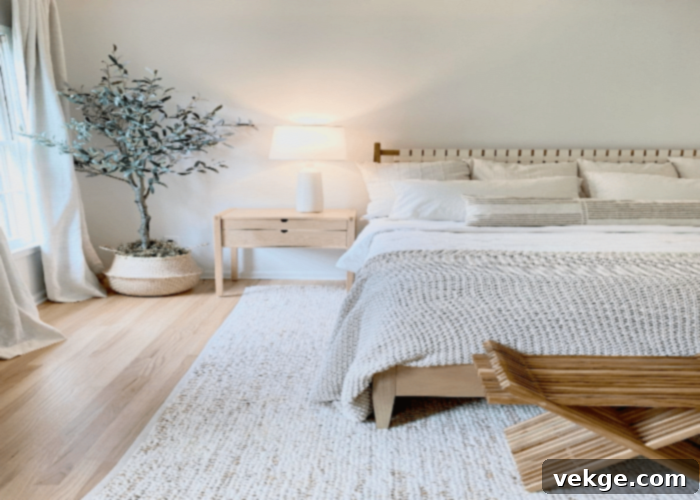
Final Thoughts on Preserving Your Scandinavian Sanctuary
In conclusion, the care and maintenance of your Scandinavian bed involve a thoughtful combination of regular cleaning, periodic deep cleaning, and diligent preventive measures. By making sure you consistently follow these guidelines, you not only increase the longevity and durability of your bed but also truly preserve and enjoy the essence of Scandinavian design, which is rooted in sustainability, functionality, and timeless beauty.
Scandinavian beds are meticulously designed with a profound focus on sustainability and usefulness. This philosophy is evident in every aspect of their design and construction, from the choice of high-quality, often responsibly sourced, materials to the conscious attention given to every detail. They seamlessly blend comfort, natural serenity, and robust sturdiness to cultivate a comfortable and serene lifestyle. Your Scandinavian bed is more than just a place to sleep; it’s a perfect space for you to unwind, relax, and immerse yourself in a minimalist yet undeniably luxurious living experience that can endure for decades with proper care.
Frequently Asked Questions About Scandinavian Beds
What Defines a Scandinavian Bed?
A Scandinavian bed is a piece of furniture characterized by its harmonious blend of minimalism, functionality, and comfort. It embodies the core tenets of Scandinavian design, featuring clean lines, a simple aesthetic, and often a neutral or earthy color palette. These beds prioritize natural materials, light wood tones (like oak, pine, or birch), and practical design elements, creating a calm, uncluttered, and inviting atmosphere in the bedroom.
What Materials are Typically Used for Scandinavian Beds?
The materials chosen for Scandinavian beds are selected with great care, focusing on natural origin, durability, and comfort. For the frames, popular choices include light-colored woods such as solid oak, pine, ash, or birch, often finished with natural oils or clear lacquers to highlight the wood’s inherent beauty. For mattresses, the emphasis is on providing superior comfort and ensuring good quality sleep. Common selections include high-quality memory foam, supportive latex, or advanced pocket spring mattresses, all chosen for their ergonomic properties and longevity. Some Scandinavian beds may also incorporate natural textiles like linen, cotton, or wool for headboards or subtle upholstery, maintaining the natural aesthetic.
Are Scandinavian Beds Practical in Design?
Absolutely. Scandinavian beds are renowned for their exceptional practicality and intelligent design solutions, seamlessly integrating functionality with aesthetic appeal. Many designs offer clever storage solutions, such as integrated under-bed drawers or discreet shelves, which provide ample space for bedding, books, or personal items without compromising the bed’s clean lines or minimalist look. Their minimalist footprint also helps maximize floor space in smaller bedrooms. Beyond storage, their timeless design ensures versatility, allowing them to adapt effortlessly to various interior styles, and their robust construction promises years of reliable use, making them a wise and practical investment for any home.
